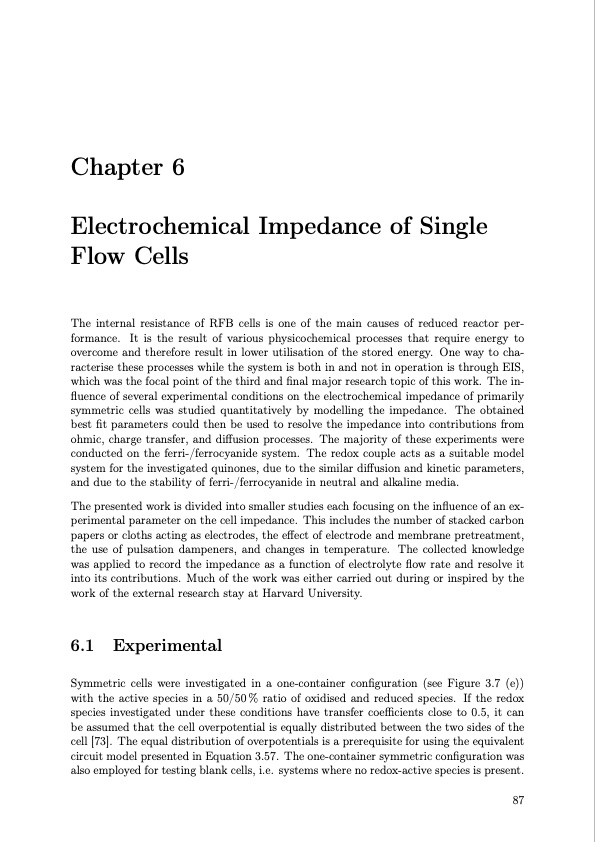
PDF Publication Title:
Text from PDF Page: 108
Chapter 6 Electrochemical Impedance of Single Flow Cells The internal resistance of RFB cells is one of the main causes of reduced reactor per- formance. It is the result of various physicochemical processes that require energy to overcome and therefore result in lower utilisation of the stored energy. One way to cha- racterise these processes while the system is both in and not in operation is through EIS, which was the focal point of the third and final major research topic of this work. The in- fluence of several experimental conditions on the electrochemical impedance of primarily symmetric cells was studied quantitatively by modelling the impedance. The obtained best fit parameters could then be used to resolve the impedance into contributions from ohmic, charge transfer, and diffusion processes. The majority of these experiments were conducted on the ferri-/ferrocyanide system. The redox couple acts as a suitable model system for the investigated quinones, due to the similar diffusion and kinetic parameters, and due to the stability of ferri-/ferrocyanide in neutral and alkaline media. The presented work is divided into smaller studies each focusing on the influence of an ex- perimental parameter on the cell impedance. This includes the number of stacked carbon papers or cloths acting as electrodes, the effect of electrode and membrane pretreatment, the use of pulsation dampeners, and changes in temperature. The collected knowledge was applied to record the impedance as a function of electrolyte flow rate and resolve it into its contributions. Much of the work was either carried out during or inspired by the work of the external research stay at Harvard University. 6.1 Experimental Symmetric cells were investigated in a one-container configuration (see Figure 3.7 (e)) with the active species in a 50/50% ratio of oxidised and reduced species. If the redox species investigated under these conditions have transfer coefficients close to 0.5, it can be assumed that the cell overpotential is equally distributed between the two sides of the cell [73]. The equal distribution of overpotentials is a prerequisite for using the equivalent circuit model presented in Equation 3.57. The one-container symmetric configuration was also employed for testing blank cells, i.e. systems where no redox-active species is present. 87PDF Image | Organic Redox Flow Batteries 2023

PDF Search Title:
Organic Redox Flow Batteries 2023Original File Name Searched:
PhD_thesis_final_dorhoff_4_.pdfDIY PDF Search: Google It | Yahoo | Bing
Salgenx Redox Flow Battery Technology: Salt water flow battery technology with low cost and great energy density that can be used for power storage and thermal storage. Let us de-risk your production using our license. Our aqueous flow battery is less cost than Tesla Megapack and available faster. Redox flow battery. No membrane needed like with Vanadium, or Bromine. Salgenx flow battery
| CONTACT TEL: 608-238-6001 Email: greg@salgenx.com | RSS | AMP |